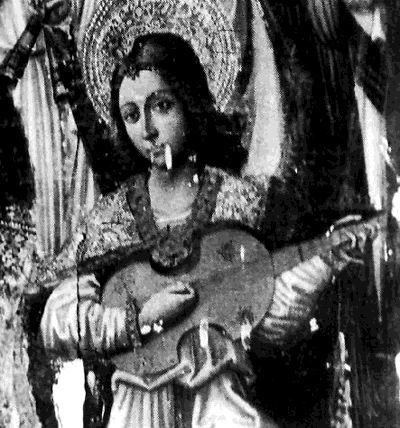Angel vihuelista. Maestro de Perea, detail
(1491 ca) - Formerly in the Colegiata, Játiva. Destroyed during Spanish civil war.
instrument: vihuela de mano | century: 15cent/3/late | catalogue nº: 15-334

Artwork
Creator Maestro de Perea
Medium Artwork: Painting
Location
City Játiva | Region Valencia | Old kingdom Aragon
Characteristics
| Body Corners | Strings courses | Neck Long | Pegbox Angled channels |
| Bridge Fixed | Frets Yes | Back Flat | Pegs Lateral |
| Technique Plucked |
Commentary
ARTWORK
The “Madonna and Child” featuring this vihuela-playing angel is a Hispano-Flemish work of the Aragonese school, dated late in the 15th century. It was a section of the altarpiece Retablo de Santa Ana, formerly in the Collegiate church in Játiva but destroyed during Spanish civil war. The painter, the Perea Master was a contemporary of Rodrigo de Osona. Most of his datable works are after 1491. Bordas (bordas1991), nevertheless suggests that it might date from mid-century.
INSTRUMENT
Angel musicians are depicted around Madonna. The vihuela appears among other instruments. Its body is of cornered waists less than 1/3 length of body. No soundhole is visible. The bridge is located approximately 1/6 along body. There are four geometric decorations on belly, inlaid taraceas. The neck is particularly narrow and carries 6 strings. It appears to have ten frets, with a flat pegbox at right angles to the neck. It was apparently meant to have double courses as at least five pegs visible on upper side of pegbox. The instrument is being played with a plectrum.